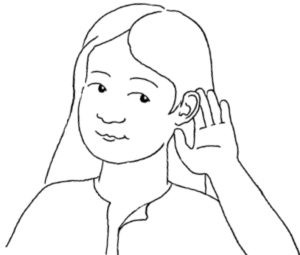Procedure:
- The students are queried about what communication means to them and examples for communication situations are compiled. The instructor then draws a simple diagram on the board (sender – receiver) and explains: “communication can be understood as ping-pong between two persons – the sender and the receiver. If they want to understand each other well, they must be able to communicate as reliably as possible. This also implies that the sender formulates his/her message as precisely as possible. Moreover, the word message is generally also accompanied by non-verbal signals, such as smiling, frowning or gestures. A successful communication also implies that the receivers listen carefully so as not to interpret the message erroneously”.
- In the ensuing discussion, the students compile ideas of how a good receiver shows his/her interest in the messages in that s/he is actively listening. The worksheets are distributed to the class, the suggestions are discussed and possibly supplemented.
- The students form groups of three in order to practice active listening. In the first round, student 1 is the sender and student 2 is the receiver and active listener, respectively. The task of student 3 is to observe the active listening of student 2 and to report his/her findings to the group. There are three rounds, so that each student can assume each role once. The instructor suggests themes for the sender, such as: “when I needed help”, “what I would like to do better”, “a problem I would like to solve”. The senders select a topic and remember to include pauses when speaking, thus allowing the receiver to respond. The instructor gives the signal to start, and then ends the round after 3 minutes. The observers have 1 minute to complete their report, then the roles are changed. In the end, the students fill out the worksheets individually.
- Reflection and discussion with the class as a whole. How did you feel as an active listener? What was it like for the observer? When you were the sender, how did you feel when someone listened attentively to you? When you were an active listener, what was easiest, what was the most difficult aspect? What did you learn from the observer? Why is it important to be able to listen well? Remember a situation where you were able to listen well! Share an example of when you were proud of yourself because you received good feedback based on your active listening.
WS – Am I a good listener?
Worksheet for students
As a good listener…

- … you look at the speaker;
- … you make eye contact with him or her;
- … you are relaxed, but attentive;
- … you listen attentively and reflect on what the speaker wants to say;
- … you do not interrupt and fidget;
- … you only answer during pauses;
- … you try to feel what the speaker feels;
- … you nod, say “hmmm” or summarize quickly, so that the speaker knows that you have listened.
What you do well while listening
What is not your strength while listening?
What can you do in order to listen better?






